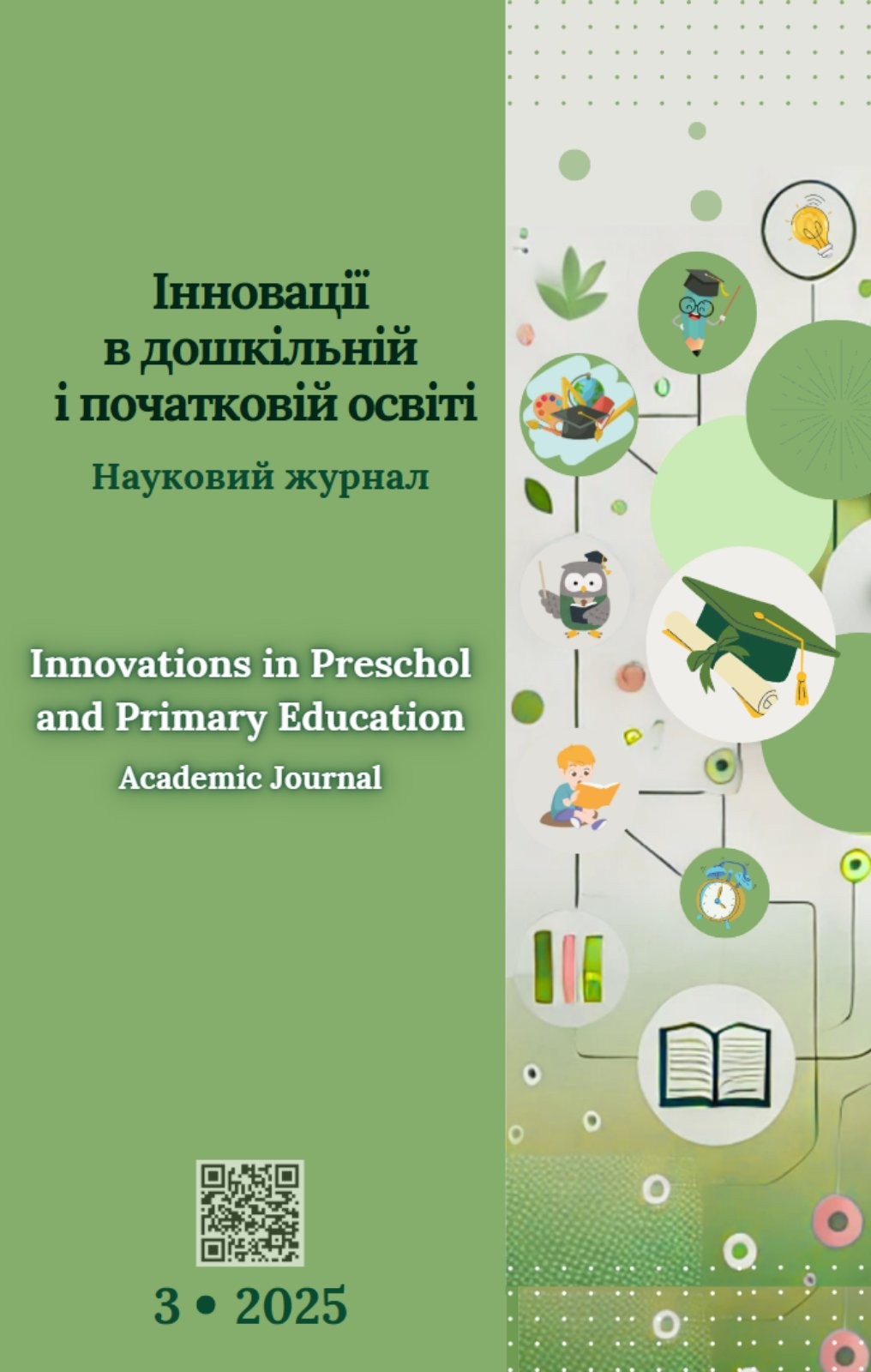Development of spatial orientations in senior preschool children in the natural environment
Keywords:
cognitive activity, spatial orientation, spatial orientations, natural environment, space, spatial imaginationsAbstract
The possibilities of using foot walks in a fresh air in the development of spatial orientations in senior preschool children were substantiated in the article. The content of the notions «cognitive activity», «space», «spatial imaginations», «spatial orientation» in philosophical, psychological-pedagogical and methodical contexts were specified. The author‟s interpretation of the essential content of the concept of «development of spatial orientations» was proposed. In the context of the activity approach, the essentials of the development of spatial orientations in senior preschool children in the process of daily walks were revealed. It was proved that the realization of educational tasks with children is aimed at developing of the randomness of their cognitive processes, the ability to operate with sensory imaginations, impressions and judgments, to coexist and self-realise in a safe natural environment. In particular, the kinds of cognitive activity and the boundaries of their realization were characterized, the diversity of forms was presented.A comparative characteristic of various forms of health-improving work with children (walks-hikes, pedestrian crossing, walking strolls etc.) reveals the impact of the natural environment on the thorough development of a six-year-old child, in particular the development of their spatial orientations.The essence of the philosophical concepts of natural (life) space allows us to understand the aesthetic potential of nature, the psychological and pedagogical regularities of its mastering by a child. The analysed scientific sources present space as an environment for healing and improvement, in particular the field of one‟s own self-determination and responsibility.Special attention was paid to the arsenal of pedagogical means during active directorial interaction, the practice of using the natural environment, its informativity for the formation of key competencies and cross cutting skills in senior preschool children.References
1. Baier, O. M. & Pirozhenko, T. O. (Ed.). (2021). Bazovyi komponent doshkilnoi osvity: nova redaktsiia [Basic component of preschool education: new edition]. Retrieved from: https://surl.li/ncowoe [in Ukrainian].
2. Bielenka, H. V. & Mashovets, M. A. (2018). Prohulianka – chas yaskravykh vrazhen, aktyvnosti i piznannia [A walk – a time of bright impressions, activity, and cognition]. Vykhovatel-metodyst doshkilnoho zakladu – Preschool teacher-methodologist, 6, 52-60. Retrieved from: https://surl.li/xgjxec [in Ukrainian].
3. Bilan, O. I. (Ed.). (2022). Prohrama rozvytku dytyny doshkilnoho viku «Ukrainske doshkillia» [Child development program of preschool age Ukrainian Preschool]. Ternopil: Mandrivets. [in Ukrainian].
4. Holota, N. M. (2018). Dovkillia yak zasib piznannia dytynoiu doshkilnoho viku prostoru ta chasu [The environment as a means of preschool children‟s spatial and temporal cognition]. Naukovyi chasopys NPU im. M. P. Drahomanova. Teoriia i praktyka navchannia ta vykhovannia – Scientific journal of the M. P. Dragomanov National Polytechnic University. Theory and practice of teaching and upbringing, 29, 45-51. Retrieved from: https://elibrary.kubg.edu.ua/id/eprint/24668 [in Ukrainian].
5. Dementieva, K. Yu. (2023). Rozvytok prostorovykh oriientuvan starshykh doshkilnykiv u protsesi orhanizatsii pishykh prohuliatok: kvalifikatsiina robota [Development of spatial orientation of older preschoolers during walking tours: qualification paper]. Kryvyi Rih. Retrieved from: https://surl.li/hdbnfj [in Ukrainian].
6. Kovalenko, O. V. & Berezna, Yu. V. (2021). Teoretychni osnovy formuvannia prostorovykh uiavlen u ditei doshkilnoho viku [Theoretical foundations of the formation of spatial concepts in preschool children]. Innovatsiina pedahohika – Innovative pedagogy, 37, 342-344. Retrieved from: https://doi.org/10.32843/2663-6085/2021/37.69 [in Ukrainian].
7. Nesterenko, T. V. (2019). Orhanizatsiia prohuliatok u doshkilnomu zakladi: tsikavo ta bezpechno [Organization of walks in a preschool institution: Interesting and safe]. Doshkilna osvita: problemy, poshuky, innovatsii – Preschool education: problems, searches, innovations, 8, Part 2, 85-91. [in Ukrainian].
8. Ozdorovchyi turyzm yak zasib pokrashchennia zdorovia ta rukovoi aktyvnosti ditei starshoho doshkilnoho viku [Health tourism as a means of improving the health and physical activity of older preschool children]. Retrieved from: https://bdpu.org.ua/wp-content/uploads/2021/04/2.-Turyzm.pdf [in Ukrainian].
9. Osychenko, H. O. (2015). Istorychni peredumovy formuvannia i rozvytku pishokhidno prohuliankovykh prostoriv mista [Historical prerequisites for the formation and development of pedestrian-walking spaces in the city]. Mistobuduvannia ta terytorialne planuvannia – Urban planning
10. Osychenko, H. O. & Kondrashchenko, O. V. (2017). Osoblyvosti proektuvannia pishokhidno prohuliankovykh prostoriv [Features of pedestrian-walking space design]. Suchasni problemy arkhitektury ta mistobuduvannia – Modern problems of architecture and urban planning, 47, 319-326. Retrieved from: http://nbuv.gov.ua/UJRN/Spam_2017_47_42 [in Ukrainian].
11. Storozheva, V. V. Formuvannia u doshkilnykiv prostorovykh uiavlen [Formation of spatial concepts in preschoolers]. Retrieved from: http://dspace.pnpu.edu.ua/bitstream/123456789/9675/1/26.pdf [in Ukrainian].
12. Cherkesova, Z. A. (2014). Orhanizatsiia ta provedennia prohulianky v DNZ [Organization and implementation of a walk in preschool]. Dytiachyi sadok – Kindergarten, 4, 16-23. [in Ukrainian].

